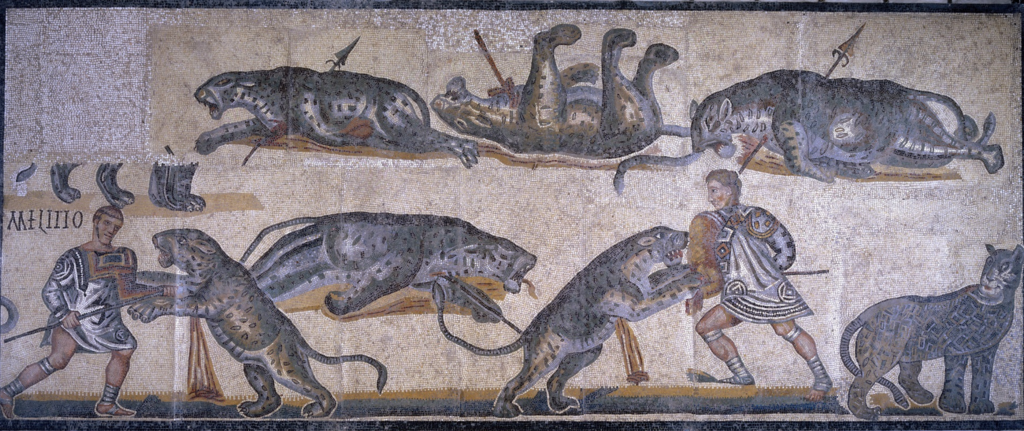
5.1
[1] Psȳchē tenerīs et herbōsīs locīs in ipsō torō rōscidī grāminis suāve recubāns, tantā mentis perturbātiōne sēdātā, dulce conquiēvit. Iamque sufficientī recreāta somnō placidō resurgit animō. [2] Videt lūcum prōcērīs et vāstīs arboribus cōnsitum, videt fontem vitreō latice perlūcidum; mediō lūcī meditulliō prope fontis adlāpsum domus rēgia est aedificāta nōn hūmānīs manibus sed dīvīnīs artibus. [3] Iam scīrēs ab introitū prīmō deī cuiuspiam lūculentum et amoenum vidēre tē dīversōrium. Nam summa laqueāria citrō et ebore cūriōse cavāta subeunt aureae columnae, parietēs omnēs argenteō caelāmine conteguntur bestiīs et id genus pecudibus occurrentibus ob ōs introeuntium. [4] Mīrus prōrsum homō immō semideus vel certē deus, quī magnae artis suptīlitāte tantum efferāvit argentum. [5] Enimvērō pavīmenta ipsa lapide pretiōsō caesim dēminūtō in varia pictūrae genera discrīminantur: vehementer iterum ac saepius beātōs illōs quī super gemmās et monīlia calcant! [6] Iam cēterae partēs longē lātēque dispositae domūs sine pretiō pretiōsae tōtīque parietēs solidātī māssīs aureīs splendōre propriō coruscant, ut diem suum sibī domus faciat licet sōle nōlente: sīc cubicula sīc porticūs sīc ipsae valvae fulgurant. [7] Nec sētius opēs cēterae maiestātī domūs respondent, ut equidem illud rēcte videātur ad conversātiōnem hūmānam magnō Iovī fabricātum caeleste palātium.
Summary: Psyche wakes to discover a shining palace.
suāve and dulce here act adverbially.
mediō…meditulliō: Note the redundancy.
prope fontis adlāpsum: “Near the downward flow of the spring.”
scīrēs: Note the use of the second person. This could be a result of narration: the speech is told from the old woman to Charite, but it is also from Lucius or Apuleius to the reader. Kenney, however, interprets this as “a characteristic Ovidian idiom… not found in other Augustan poets” and considers Apuleius’ other references to Ovid (138).
columnae: subject of subeunt.
id genus: adverbial acc.; “similar” (Kenney, ad loc).
occurrentibus ob ōs introeuntium: “Meeting your eye as you entered” (literally “running to meet the face of those entering”); see example of such a mosaic under Media.
beātōs illōs: acc. of exclamation: “How blessed are those…!”
super: used here adverbially.
sine pretiō pretiōsae: an oxymoron meaning “pricelessly priceful” (Kenney, ad loc.); describes domūs.
licet: “although.”
herbōsus, -a -um: grassy
roscidus, -a -um: dewy
grāmen, -inis n.: grass
recubo, -āre: to lie down, recline
perturbātio, -ōnis f.: confusion, disturbance
lūcus, -i m.: grove
prōcērus, -a, -um: tall, long, lofty
vītreus, -a, -um: shining, glassy
latex, -icis m.: water
perlūcidus, -a, -um: transparent
adlāpsus, -ūs m.: a flowing, gliding
lūculentus, -a, -um: bright, splendid, distinguished
amoenus, -a, -um: lovely, charming
dīversōrium, -ī n.: inn, lodging-house
laquear, -āris n.: paneled ceiling
cītrum, -i n.: citrus wood
cavō, -āre: to make hollow, carve out
caelāmen, -inis n.: a bas-relief; a wall-carving where the image is carved slightly out of the wall (see example under Media).
subtīlitas, -ātis f.: subtlety, acuteness
effero, -āre: here, to bring to life
pavīmentum, -i n.: a floor composed of small stones
caesim: (adv.) by cutting, with cuts
dēminuō, -ere, -ui, -ūtus: to make smaller
discrīminō -āre: to divide, distinguish
monīle, -is n.: necklace, (pl.) jewels
calcō, -āre: to walk (on), to tread (acc.) under foot
solidō, -āre: to make firm, fasten together
coruscō, -āre: to gleam
valva, -ae f.: double door
sētius (adv.): to a lesser degree, less
Marble bas-relief of Cupid sacrificing at an altar to the fertility god Priapus from the 2nd-3rd century CE in Rome (London, British Museum)
occurrentibus ob ōs introeuntium: Roman floor mosaic depicting gladiators and hunters from the 3rd-4th centuries CE (Rome, Galleria Borghese)
